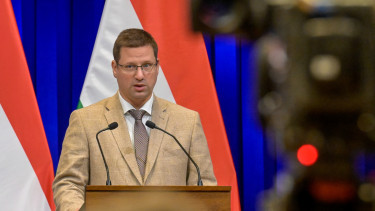Europe will almost certainly avoid a recession, but huge uncertainties remain

Europe will avoid recession, but even next year will be ragged
Europe's economic outlook has changed significantly since last year, with recession expectations projected for summer 2022 already easing in the autumn, and the outlook for the euro area continuing to improve as energy prices have fallen significantly. While a deep recession is not expected this year, the economy has already started to slow and a mild recession cannot be ruled out.
"The decline in energy prices, combined with alleviated fears of energy shortages, have indeed fuelled a sense of relief after some over pessimism," Hélène Baudchon, senior analyst at BNP Paribas, told Portfolio in an e-mailed response.
She added that this explains part of the less gloomy outlook for the Eurozone economy in the short-term.
According to the French bank,
a recession looks less inevitable and they now expect Eurozone GDP to avoid contraction and quarterly growth to be very modest but positive (a bit below +1% in annual average terms in 2023 as well as 2024).
"However, the risk of recession has not fully disappeared either. We have not yet seen all the negative lagged impacts of the inflation shock, the energy crisis and, above all, the monetary tightening," Baudchon added.

Economists at Austria's Erste Bank do not project a recession for this year, either. Rainer Singer forecasts a GDP growth of 0.6% for 2023 and 1.2% for 2024. "Of course declining energy prices are a boon for the outlook of the Eurozone economy and should help to stabilize the economy," he noted.
"Thus far the Eurozone has proven its resilience against higher energy prices and headwinds from the global economy in the second half of 2022. Of course, public support has helped households and companies, especially in the manufacturing sector," said Singer.
Now, with gas prices well below the 2022 peak, energy is unlikely to cause a recession,
Luca Mezzomo, Head of Macroeconomic Analysis at Intesa Sanpaolo, told Portfolio, also underlining that the European economy has been more resilient than expected in face of the energy crisis.
"Nonetheless, the tightening of monetary policy will restrain the interest sensitive components of demand, with an impact that we expect to peak in the second half of 2023," he said, with his bank projecting GDP growth to remain subdued, forecasting 0.6% growth for this year and 1.2% for next (just like Erste).
The dampening impact of rate hikes was highlighted also by Ralph Solveen, economist at Germany's Commerzbank. He expects the economy to remain weak this year, finding it quite possible that the economy will also contract in two consecutive quarters, thus meeting the frequently used definition of a recession. On average for the year, Commerzbank expects euro area real GDP to stagnate this year.

The eurozone economy is palpably slowing, with growth reaching 0.3% on a quarterly basis in July-September and then slowing to 0.1% in the fourth quarter. This also came as an upside surprise when the data was released, as the eurozone economy has so far avoided a downturn.
European economy dragged down by China, propelled by ECB and the USA
Besides decreasing energy prices there are other external factors that could support economic growth in Europe this year. China, for instance, has ended its zero-Covid policy at the start of 2023, as a result of which the giant Asian economy is likely to take off, boosting Chinese demand and mitigating supply disruptions. The Chinese reopening is widely expected to bolster the European economy this year, but the overall picture in the euro area remains bleak due to other factors.
GDP growth will be less supported by fiscal measures and the release of excess savings than in 2022,
said Luca Mezzomo, adding that capital spending and housing investment may be restrained by tighter financing conditions. According to the senior economist at Intesa Sanpaolo, exports may be stronger, thanks to the recovery in China, but he does not expect brilliant growth in 2023 and 2024, saying "higher real rates will bite."
Ralph Solveen has also pointed to numerous risk factors. In his view, the most important is without question a further escalation of the Ukraine war. "One reason for hope, in addition to somewhat lower energy prices again, is the emerging recovery in China now that the government there has ended its zero-Covid policy. However, the renewed strength of demand from China is likely to be more than neutralized by the weaker domestic economy," he added.
Erste's Rainer Singer agrees that the most supportive factor for the growth outlook of the Eurozone is the re-opening of the Chinese economy, which "should give especially export oriented companies a growth boost" this year.
He noted that substantially lower energy prices have given manufacturing companies gains in competitiveness versus global competitors. "Softer demand from a slowing US economy is on the other a slight dampening factor for the growth outlook of the Eurozone," he warned, though.
"China reopening plays a positive role too in addition to pent-up activity linked to diminishing supply constraints, fiscal support and labor market tightness," said Hélène Baudchon.
"[...] as inflation proves persistent and disinflation will take time, policy rates are likely to be set higher-for-longer, increasing headwinds to growth. Pressures on corporate margins (coming from higher labor costs, lower demand prospects, tighter financial conditions, diminished pricing power) are expected to build over the coming quarters, weighing on investment and hiring decisions," she added.
Inflation outlook remains murky
The rate of price increases remains well above the ECB's target. At the end of last year and the beginning of this year, there were widespread expectations that euro area inflation would ease significantly in 2023 and approach the central bank's 2% target from above. February's data came as a bitter surprise, with inflation falling from 8.6% to just 8.5%.

The inflation rate in the euro area will almost certainly fall in the coming months, as energy prices are unlikely to rise again as strongly as they did last spring,
said Ralph Solveen. "Food inflation is also likely to be close to its high. However, the core rate will remain high and fall only gradually later in the year," he added.
Due to base effects from energy prices (especially gas and electricity) Singer also expects headline inflation to gradually decline in the coming months. "Even though due to energy subsidies in some countries (eg France and Spain) headline inflation could remain elevate since declining wholesale prices will not have a meaningful dampening impact on energy bills of households in these countries. While in other countries (such as the Netherlands, Belgium and Italy) declining wholesale prices for gas and electricity are already having a substantial dampening effect on consumer price inflation. Then there are countries such as Austria or Germany where declining energy prices will reach households only with a significant delay of time and will thus dampen inflation dynamics later in 2023," he said.
"We also expect that the reopening of the Chinese economy will ease pressures on global supply chains further, which should improve the situation of the supply side and should ease inflationary pressure from goods in the coming months," he added.
Baudchon also expects Eurozone headline inflation to continue to fall because base effects on energy prices remain favorable.
"Inflationary pressures have also quite significantly abated judging by lower input prices and delivery times and this should translate into lower core goods inflation normally in a not-too-distant future. But the pace of disinflation is sharply limited by still rising food and core inflation," she said.
This is bad news but this does not come as a surprise. At such elevated and broad based levels, we knew inflation would show stickiness and inertia.
The economist at BNP Paribas added that diffusion effects of past price increases are still at work. "Price resets push inflation up too (hopefully temporarily). Against a background of strong wages inflation, services inflation will be slow to reverse. The imbalance between weak supply and strong demand is only slowly narrowing for now. The recovery in supply (investments, fading constraints) and lower demand (central banks’ action, inflation) should nonetheless help diminish price pressures more significantly in the coming months."
| Price changes of select products in the euro area (%, yr/yr) | |||||||
| Category | Feb 2022 | Sept 2022 | Oct 2022 | Nov 2022 | Dec 2022 | Jan 2023 | Feb 2023 |
| Food, alcohol, tobacco | 4.2 | 11.8 | 13.1 | 13.6 | 13.8 | 14.1 | 15 |
| Energy | 32.0 | 40.7 | 41.5 | 34.9 | 25.5 | 18.9 | 13.7 |
| Non-energy industrial goods | 3.1 | 5.5 | 6.1 | 6.1 | 6.4 | 6.7 | 6.8 |
| Services | 2.5 | 4.3 | 4.3 | 4.2 | 4.4 | 4.4 | 4.8 |
| All items HICP | 5.9 | 9.9 | 10.6 | 10.1 | 9.2 | 8.6 | 8.5 |
| Sources: Eurostat, Portfolio | |||||||
Mezzomo thinks that inflation will fall rather quickly because of the direct and indirect effects of the decline in gas prices. "However, the path will be bumpy, because governments will cut the subsidies and phase out the temporary measures introduced last year to shield households and firms," he said.
Besides, he expects workers to ask for some compensation for the loss of purchasing power.
Wages are the main cost factor in services, which may result in more inflation persistence in services.
According to Intesa Sanpaolo, core inflation will probably decline from the second quarter of this year, but mostly because of core manufactured goods and the stabilization of prices in contact-intensive services, which have risen a lot already after the pandemic. It is not yet clear whether the landing point will be below or above 2%, Mezzomo added.
Singer also highlighted services inflation, saying it is an open question how sticky it will be going forward.
Wage pressure has been rather muted until 3Q 2022, however, wage adjustments tend to be a lagging factor. So possible wage increases are a risk factor for the outlook of services inflation and thus for core inflation in 2023.

Where could the ECB's rate hike peak?
We think the ECB deposit rate will peak at 3.5%. We expect a 50 basis points hike in March and 25 bp each in May and June,
said Gerald Walek, economist at Erste Bank, in an e-mailed response to Portfolio, in relation to the ECB's policy.
Luca Mezzomo said that since November last year, he has expected the terminal rate to be 3.50%, with some upside risks, and recent data have not changed his assessment.
"To some extent, it will depend on the intensity of the transmission of monetary policy: the more the tightening of financing conditions, the lesser the need to raise rates. Second, the ECB job would also be easier if firms become concerned by the outlook for demand; if they stay bullish, they are more likely to pass on cost increases. Third, it will also depend on global demand. If demand is not subdued, then I guess that rates could rise somewhat more."
Ralph Solveen also sees the peak at 3.5%, while Hélène Baudchon
projects the terminal ecb deposit rate to peak at 4.0% in july this year.
The BNP Paribas economist pointed out that the economy is proving more resilient than expected and disinflation even more sticky, projecting two hikes of 50 basis points both in March and May followed by +25 bp in June and July.
The ECB started raising interest rates in July last year, and since then the benchmark deposit rate has been increased by three percentage points. The Frankfurt-based bank last raised rates by 50 basis points in January, and the statement at the time said another 50 basis point increase was expected in March. The central bank has promised to decide on interest rates after March in light of incoming data.

The ECB's tight monetary policy raises the question of how much damage it will do to the economy (although, for that matter, the debate is much more lively in the US).
By raising interest rates, the central bank is curbing demand in order to reduce activity and ease inflationary pressures. If the monetary policymaker over-tightens, the cost of disinflation can be high. This question inevitably arises today, as the ECB has never in its history raised interest rates to such an extent, and at such a rapid pace.
The analysts polled agreed that the ECB's focus is now primarily on disinflation, and that the focus can only shift towards economic slowdown as inflation moderates.
In their response to Portfolio, the economists said that they do not reckon that the central bank should stop raising interest rates despite the possibility that inflation could be moderating substantially, although Ralph Solveen said that a situation could arise where the ECB reacts to a decline in the headline inflation rate and a slowdown in the economy by stopping interest rate hikes despite the fact that core inflation is still high at that point.
Bond yields could rise further
In November, we saw a change in sentiment, with the market believing that US inflation had peaked and the Fed rate hike cycle was coming to an end. In February, we saw another turnaround, as the US labour market expanded more than expected, and then January's inflation data disappointed, with disinflation slowing significantly overseas. This has again repriced expectations of the Fed's interest rate path, which has led to a strengthening of the dollar after two months of depreciation. The shift in market sentiment has not left the euro unfazed and the bond market could not escape it either.
The key data will be published in the coming weeks, with the US government releasing February employment data on Friday and February inflation data next week. These data will determine market movements for the coming weeks and months. Analysts were asked what impact a slower-than-expected disinflation, and consequently a stronger Fed action, could have on European assets and what the ECB should do in such a scenario.

Baudchon replied that as both the Fed and the ECB are facing the same challenges at the time of writing (stubbornly high inflation, resilient growth), market expectations for each rates path are revised up for the two central banks. This drives higher long-term rates on both sides of the Atlantic, she added.
"The net impact on the EURUSD at the end of the day is however unclear for me unfortunately. But assuming the EURUSD depreciates significantly again like in 2022, fueling imported inflation, this will argue for a more hawkish ECB."
I see a positive correlation prevailing in the short term: higher bond yield in Europe, more expectations of ECB hikes and a weaker EURUSD exchange rate,
said Mezzomo. He added that in theory, more monetary tightening in the US should reduce the need for tightening by the ECB, but this is not the case if the additional tightening is just adaptive, that is if it is a reaction to stronger-than-expected data.
After the recent market movements, Erste Bank thinks the market is pricing in further rate hikes in the US sufficiently.
"Should US rates rise more, it would support the dollar and likely trigger higher US yields, especially on the short end. Eurozone yields would likely follow, though to which degree would depend on the economic data from the Eurozone," said Gerald Walek.

Cover photo: Getty Images









